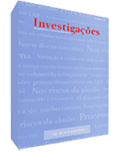A Contrução Pública do Conhecimento: Linguagem e Interação na Cognição Social
Abstract
Este trabalho foca os processos de construção do conhecimento em iinterações face a face, em instituições escolares. O objetivo é demonstrar que a construção do conhecimento não é algo realizado individualmente, nem a conseqüência de pura internalização de informação, que é recebida, tratada e armazenada na mente dos alunos. A construção do conhecimento é, pelo contrário, de natureza essencialmente pública, ancorando-se em atividades social e interacionalmente situadas, através da negociação de versões da realidade e do compartilhamento de pressupostos comuns.
References
CLARK, Herbert H. 1992. Arenas of Language Use. Chicago: Chicago UP.
______. 1996. Using Language. Cambridge: CUP.
FAUCONNIER, Gilles. 1994. Mental Spaces. Cambridge: CUP.
______. 1997. Mappings in Thought and Language. Cambridge: CUP.
FAUCONNIER, Gilles; TURNER, Mark. 2002. The way we think. Conceptual
blending and the mind’s hidden complexities. New York: Basic Books.
GOODWIN, Charles; DURANTI, Alessandro (orgs.). 1992. Rethinking
Context. language as an interactive phenomenon. Cambridge: CUP, p.142,
GUMPERZ, J. 1992, Contextualization and Understanding. In GOODWIN,
C.; DURANTI, A. (orgs.), Rethinking Context. language as an interactive phenomenon. Cambridge: CUP, p. 229-252.
GUMPERZ, John.; LEVINSON, Stephen. 1996. Rethinking Linguistic Relativity. Cambridge: CUP.
KOCH, Ingedore. 2001. A referenciação como atividade cognitiva e interacional. Anais do II Congresso Internacional da ABRALIN, UFC, Fortaleza.
______. 2002. Linguagem e Cognição: a construção e reconstrução de
objetos-de-discurso. Veredas, vol. 6, n.1, jan/jun 2002, p. 29-42.
KOCH, I.; CUNHA-LIMA, Maria Luiza. 2004. Do cognitivismo ao sociocognitivismo. In MUSSALIN, Fernanda; BENTES, Anna Christina (orgs), Introdução à Lingüística. Fundamentos Epistemológicos, Vol. 3. São Paulo: Cortez, p.251-300.
LAKOFF, George. 1987. Women, fire and dangerous things. Chicago/
London: The University of Chicago Press.
______; JOHNSON, Mark. 2002. [1980]. Metáforas da vida cotidiana.
Tradução Brasileira. Campinas: Mercado de Letras; São Paulo: EDUC.
MARCUSCHI, Luiz Antonio. 2001. Atos de referenciação na interação face
a face. Anais do II Congresso Internacional da ABRALIN, UFC, Fortaleza.
______. 2004. O diálogo no contexto da aula expositiva: continuidade,
ruptura e integração. Recife (mimeo).
MONDADA, Lorenza. 2001. Pour une approche conversationnelle des
objets de discours. Anais do II Congresso Internacional da ABRALIN. Fortaleza: UFC.
______. 2002. Cognition et parole-en-interaction. Veredas. Vol.6, n. 1.
jan/jun, Juiz de Fora: Editora da UFJF, p.9-27.
OCHS, Elinor. 1979. Transcription as theory. In OCHS, E.; SCHIEFFELIN,
B. (eds), Developmental Pragmatics, New York: Academic Press, p. 43-72.
ONO, T.; THOMPSON, S. 1996. The dynamic nature of conceptual
structure building: evidence from conversation. In GOLDBERG, A, Conceptual structure, discourse and grammar. Stanford: CLSI.
SALOMÃO, Margarida. 1997. Gramática e Interação: o enquadre programático da hipótese sócio-cognitiva da linguagem. Veredas. UFJF. Vol. 1, no. l, p.23-39.
______. 1999. A questão da construção do sentido e a revisão da agenda dos estudos da linguagem. Veredas. UFJF. Vol. 3, no. 1, p.61-79.
Downloads
Published
How to Cite
Issue
Section
License
Copyright (c) 2007 Jan Edson Rodrigues-Leite

This work is licensed under a Creative Commons Attribution 4.0 International License.
Authors who publish with Revista Investigações agree to the following terms:
Authors retain copyright and grant the journal right of first publication with the work simultaneously licensed under the Creative Commons Attribution 4.0 International (CC BY 4.0) license that allows others to share the work with an acknowledgement of the work's authorship and initial publication in this journal.
Authors are able to enter into separate, additional contractual arrangements for the non-exclusive distribution of the journal's published version of the work (e.g., post it to an institutional repository or publish it in a book), with an acknowledgement of its initial publication in this journal.
You are free to:
Share — copy and redistribute the material in any medium or format for any purpose, even commercially.
Adapt — remix, transform, and build upon the material for any purpose, even commercially.
The licensor cannot revoke these freedoms as long as you follow the license terms.
Under the following terms:
Attribution — You must give appropriate credit , provide a link to the license, and indicate if changes were made . You may do so in any reasonable manner, but not in any way that suggests the licensor endorses you or your use.
No additional restrictions — You may not apply legal terms or technological measures that legally restrict others from doing anything the license permits.

